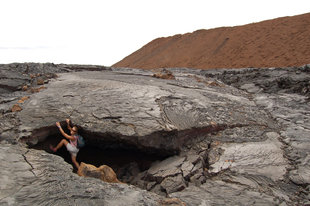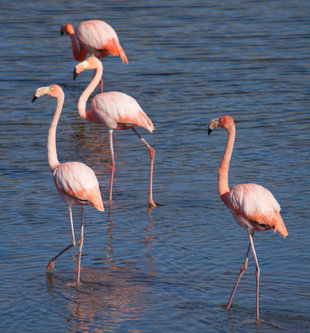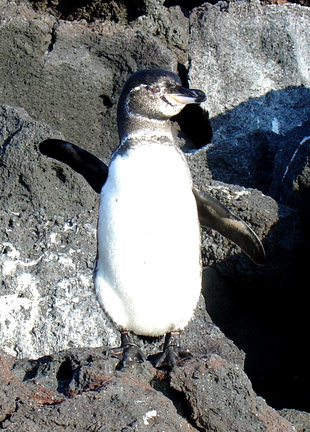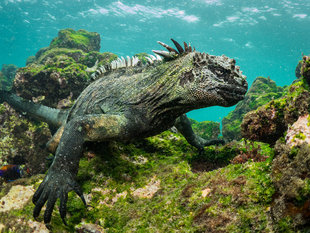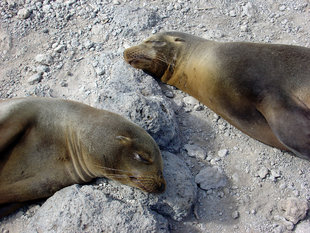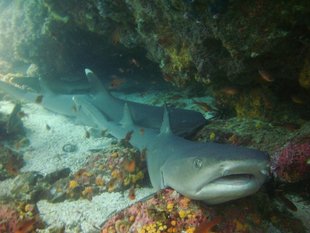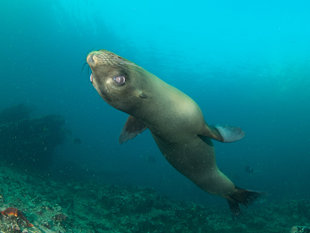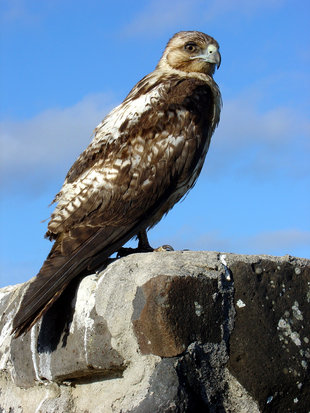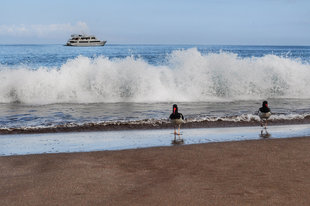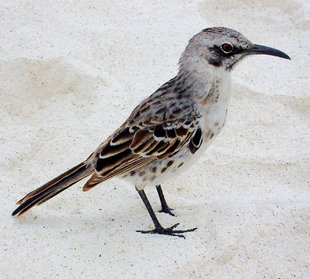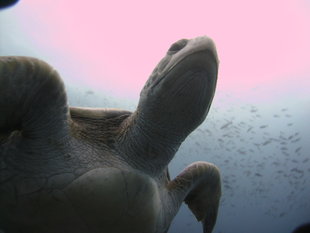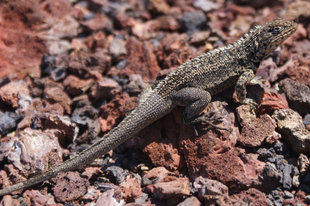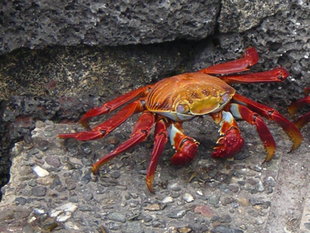Area Size: 558 Km²
Maximum Altitude: 906 meters / 2975 feet
Island Highlights: James Bay, Sullivan Bay, Puerto Egas, Buccaneer's Cove, Lava Lizards, Marine Iguanas, Galapagos Penguin, Galapagos Fur Seal, Green Sea Turtles, Mockingbirds, Oystercatchers
Introduction
Santiago is situated just west of the central part of the Galapagos Islands and is the fourth largest in the archipelago. It is an island rich in wildlife, history and geology, dominated by its phenomenal lunar landscape. Santiago has a long human history and was once a favourite haunt for pirates and whalers. Due to its central location and varied landing sites, this island is included in many of our Yacht Safari itineraries.
Santiago has a number of interesting visitor sites, all of which present great opportunities to encounter and observe wildlife. A nature trail near Espumilla beach is one such location. The visitor site at Puerto Egas is another which often provides the opportunity to swim with fur seals - an experience difficult to come by elsewhere in the Galapagos.
The neighbouring island and visitor site of Sombrero Chino also provides some very good snorkelling and there is a 400 meter nature trail here which we sometimes incorporate into Yacht Safari itineraries. Sombrero Chino boasts some fascinating geological formations and volcanic landscapes.
Nowadays, Santiago Island is uninhabited, but over the years it has endured significant environmental impacts as a result of human presence on the island. As with most of the Galapagos, the greatest impact has been through the introduction of foreign species and in particular feral goats. Furthermore, human settlers for a time embarked on salt mining, an industry which inevitably leads to visual and environmental impact.
Wildlife
Puerto Egas, located on the western coast of Santiago, is not only a fantastic location geologically; it is also the home to a variety of fascinating wildlife and therefore provides countless photographic opportunities. Marine iguanas can often be seen soaking up the sun's rays on lava rocks, while land iguanas are most likely to be seen feasting on exposed algae. Another resident of Puerto Egas is that of the yellow-crowned night herons, which can usually be spotted scurrying along the grotto in search of fish. Lava Herons and Striated Herons can also be spotted here. The surrounding tide pools are often frequented by sally lightfoot crabs, meanwhile, further along the shore one is likely to have a rare encounter with groups of fur seals.
A nature trail from Puerto Egas presents keen birdwatchers with an array or exciting bird spotting opportunities. One is likely to encounter Galapagos finches, the endemic Galapagos hawk and the strikingly colourful vermillion flycatcher.
Just 5 km up the coast from Puerto Egas lies Espumilla beach with its rich coffee coloured sand. The beach is a popular site for sea turtles, which often come and lay their eggs in the sand. This beach has an abundance of birdlife, which can be found after a short inland walk through the mangrove forest. Galapagos finches and the vermillion fly catcher are worth looking out for, while the common stilt is more frequently seen. The trail eventually leads to a brackish lagoon, where flocks of bright pink flamingos and white cheek pintails can be observed.
Sombrero Chino, a small island off the south eastern tip of Santiago has a rich and varied offering of wildlife. A 400 meter nature trail leads from the beach and around the cove, providing incredible landscapes and a wealth of wildlife. American oystercatchers are often seen along the trail, as are marine iguanas and lava lizards.
Marine Life
Puerto Egas is a very good spot for snorkelling. Its tidal pools are one of the highlights where you can see sponges, snails, hermit crabs, barnacles and colourful reef fish including the endemic four-eyed blenny. A stroll along the shore can also provide sightings of marine iguanas, bright orange sally light foot crabs and sea lions.
The cove around Sombrero Chino presents some worthwhile swimming and snorkelling opportunities, with chances to encounter white tipped reef sharks and other marine life. It is also a dive site with nice rock formations underwater, volcanic rubble and sharp rocky outcrops. The landing, which consists of a beautiful crescent shaped white sandy beach, is home to sea lions and sally lightfoot crabs.
Fur seals were once on the brink of extinction after being hunted for their coats. However, thanks to a conservation programme implemented by the national park, the fur seal population is steadily increasing. The Galapagos fur seal is much smaller in size in comparison to other fur seals in the southern hemisphere. By day they shelter from the sun's rays in nearby caves, while at night they feed off squid and fish. The fur seal grotto is one of the only areas where fur seals can be found, which offers visitors a unique opportunity to swim with them. The grotto itself is a collapsed and flooded lava tube, providing the fur seals with a degree of protection from rough seas. Here, both fur seals and sea lions can be seen swimming upside down in the rocky lava pools with their flippers out of the water.
Conservation Issues
In 1880 feral goats were introduced to Santiago. Their presence quickly started to cause devastation on the island. The goats thrived in the lush island environment, with goat numbers eventually escalating to 100,000, which subsequently stripped the land of its once dense vegetation. The Galapagos National Park Service (GNPS) has fenced off areas of land around Bucaneers Cove, an area heavily populated by this foreign invader, in order to protect the native vegetation from any more destruction. Although the GNPS has been steadily working towards eradicating the goat population, it is not unusual for visitors to see them roaming around the island and feeding on the arid vegetation.
The presence of humans on the island has inevitably made an impact on the environmental structure of Santiago. In the 1920s and 1930s, substantial mining efforts were made to extract salt through the crater. However, little profit was made from the mining, therefore further attempts were abandoned. Disused equipment and derelict buildings that can still be seen today.
Geology
Santiago is one of the most volcanically active islands in the archipelago, where numerous young lava flows and cones to be seen. The island consists of two overlapping volcanoes, one shield volcano on the northwest side; and a low linear fissure volcano on the southeast side. The oldest lava flows are approximately 750,000 years old, with the most recent eruption having occurred within the last two centuries.
Geologically, the most impressive site on the island is that of Puerto Egas on the western coast, which consists of an extensive lava shoreline, where eroded rock formations provide habitats for an array of wildlife. Both land and marine iguanas can be spotted here.
Approximately half an hour north of Puerto Egas lies Buccaneer's Cove, a former safe haven for pirates and whalers in the 18th and 19th century, where they would stock up on supplies and make any necessary repairs to their boats. Although few yachts make a landing at Bucanneer's Cove these days, many still cruise on by to observe the fascinating tuff formations and the interesting red beach made up of reddish purple sand. There are two particularly interesting geological rock formations here, known locally as the "monk" and the "elephant rock". Seabirds flock here in their hundreds and can usually be seen perching on the cliff tops.
Sullivan Bay is an interesting geological location and is possibly one of the most incredible volcanic sites in the Galapagos archipelago. There are two small beaches to be found here, which are often frequented periodically by nesting turtles. One can take the unique opportunity to walk across the existing black lava flow, characterised by lava bubbles and the moulds of tree trunks and other plant life that was engulfed by the lava stream. A reddish lava cinder cone is an excellent vantage point from which to gaze across the bay and view Pinnacle Rock on the neighbouring island of Bartolomé.
Sombrero Chino is a small island located off the south eastern tip of Santiago island. The island's name derives from its shape, reminiscent of a Chinese hat. The island was formed by a single extinct cone. The island is dominated by its volcanic landscape of sharp outcroppings, rubble and lava tubes. Despite the island's central location, it is one of the least visited sites in the area, but definitely a worthwhile visit. The National Park Service restrict visitor numbers to the island, whereby only 12 people at any one time can step foot onshore.
Santiago

